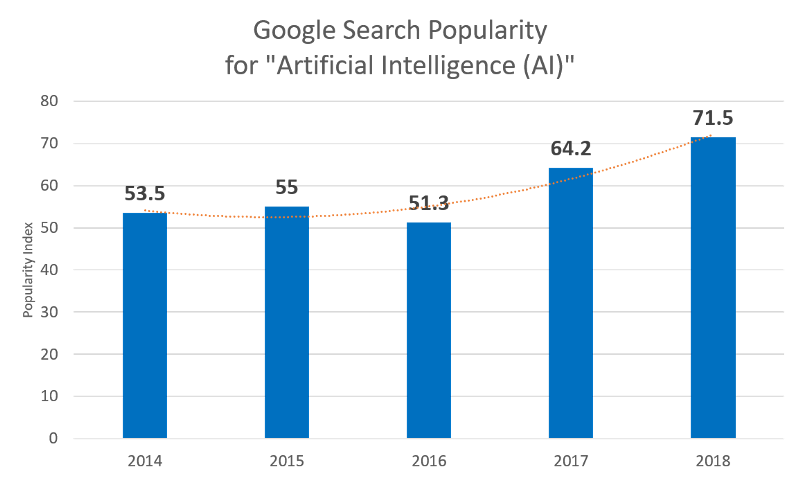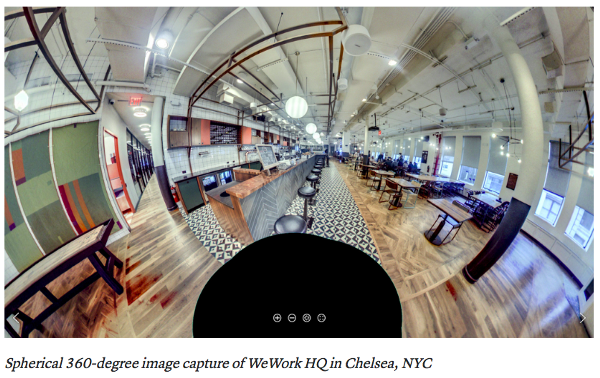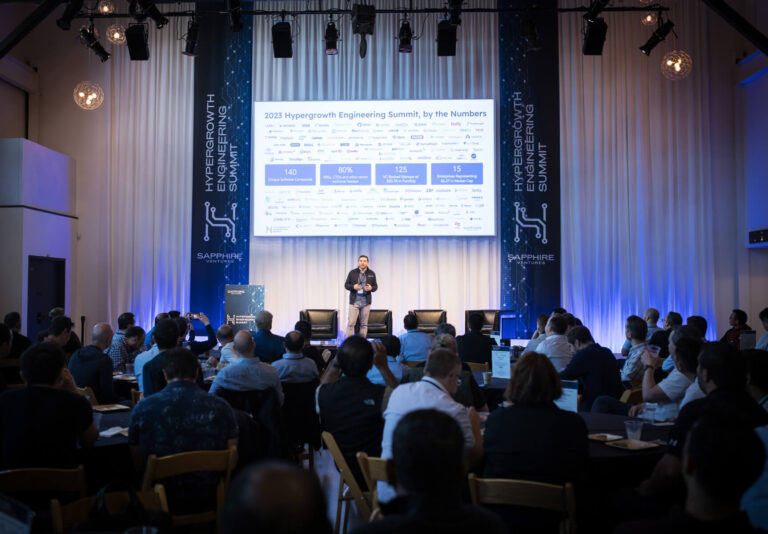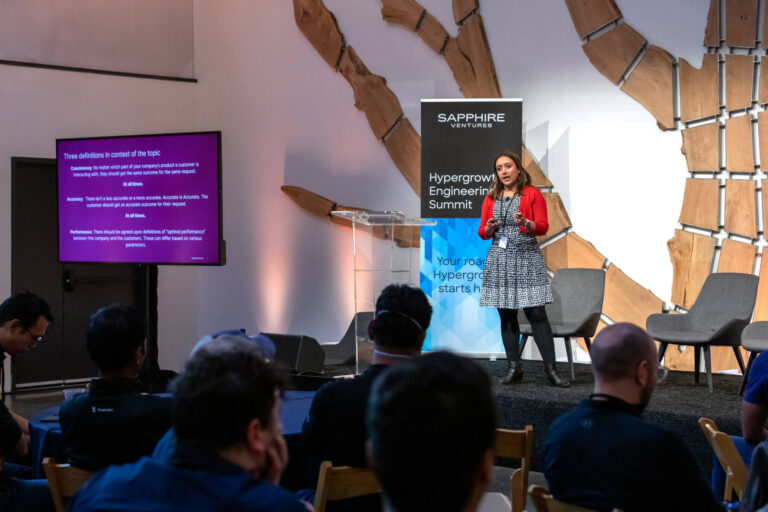At Sapphire’s 2018 CIO Summit, Databricks’ CEO Ali Ghodsi pointed out that the biggest gains in AI are quite boring. Shiny solutions like self-driving cars, Google Home, and Alexa may dominate headlines, but the real opportunities for the enterprise lie in automating mundane, lower-value tasks. Being able to save time and money on data entry, bookkeeping and tax preparation, and even surveillance in construction projects can free employees to focus on more creative, higher-value work.

For chief information officers, who increasingly find themselves on the front lines of investment in enterprise technologies, knowing where AI makes a difference can be an enormous asset as the pressure to work in more creative and efficient ways intensifies.

Public interest in AI has surged in recent years, with images like self-driving cars entering the public consciousness. Looking at Google Trends, the average search popularity index for “artificial intelligence” has grown more than 30% since 2014.
Far from entering an “era of replacement” with AI, where humanoid machines succeed people sitting at desks, manning assembly lines, or serving food, we’re facing a time of “enhancement,” as Chris Anderson, former editor of Wired and current CEO of 3DR, noted at the Summit’s opening keynote.
It’s clear that many people still have questions. This pieces provides answers for CIOs and others looking to stay on the cutting edge of AI in the workplace. Drawing in large part from discussions at the 2018 CIO Summit, we zero in on how some of the most innovative companies are incorporating AI into their workplaces — and realizing enormous gains.
The rise of data factories
There’s a lot of hype about how applying machine-learning techniques to data sets can unearth valuable insights. Companies that do this successfully are finding new links between how customers behave in their apps and when they make purchases, between specific onboarding practices and employee retention, and even between variables like the weather and the outcomes of new building projects.
The challenge for most companies, however, is that their data is siloed. Most of the Forbes Global 2000 are sitting atop troves of information, such as purchase histories, product analytics, and employee credentials, but most of the time it’s stored separately and in incompatible formats. Small samples make it hard to unlock meaningful results. In addition, if a company is trying to train machines on limited information, it’s often not enough to deliver accurate predictions.
At the CIO Summit, Ali Ghodsi pointed out that just 1% of companies — primarily Facebook, Twitter, and Google — have the architecture in place to derive significant value from their data sets. For CIOs, this highlights a massive opportunity to follow suit.
The good news is that even for organizations without Facebook’s, Twitter’s, and Google’s resources, new solutions are emerging to help them integrate, clean, and optimize their data sets and run tests at competitive speeds. Databricks, for example, can provide this infrastructure in lieu of organizations having to rebuild their existing systems. Instead of simply storing information, companies that use Databricks software can spend more time analyzing their information and turning it into more relevant products and experiences for their customers.
Using automation to get closer to customers
Interacting with a diverse set of customers on a personal level requires enormous attention to detail. In industries like retail and enterprise software, more and more sales reps rely on nuanced pieces of information, such as past app behavior, purchase histories, interests, and geography, to prospect new leads and pitch products in more meaningful ways.
AI offers ways to complement this data-driven process. At the Summit, Frerk-Malte Feller, director of Facebook’s Workplace collaboration platform, highlighted how teams are starting to lean on sentiment analysis — the process of automatically deriving opinions and other qualitative information from large blocks of text or long voice recordings — to get real-time feedback on customer calls and improve the speed and quality of complex translations. Making these small tasks more efficient helps customer support and sales teams reach more-diverse audiences and ensure that their interactions are more valuable.
The opportunity for improvement is vast. In many call centers, agents still manually enter customer contact information. After calls, the information that agents collect on the quality of customer interactions, including pain points, tone, and the resolution (or not) is rarely complete. When agents are pressed for time, details can fall through the cracks. Sentiment analysis (or emotion AI) helps monitor the quality of customer interactions in real time. The process is advanced enough to measure tones like frustration or satisfaction, based on the prevalence of certain words. While representatives previously routed customers to after-call “How was your experience?” surveys, they can now get results immediately. A quicker and richer data set helps managers support agents’ growth.
In addition, translation rates run about 10 cents a word. With many teams trying to tap into emerging markets, costs can quickly add up. Neural machine translation (NMT) is an advanced AI technique that allows teams to translate Skype calls, marketing materials, and even social media posts faster, with better quality, from English into more complex languages like Urdu and Romanian. In 2018, Facebook was able to increase its translation speed to 4.5B post impressions per day with NMT.
Improving project sequences with AI and machine learning
During the Summit’s opening keynote, Chris Anderson drew connections between AI and more traditional, physical industries. Even in construction — one of the least digitized sectors — AI is helping companies automate project sequences to be safer and more efficient.
Engineering giant Bechtel, for example, is saving millions on new projects, such as airports and power plants, by running data from past projects into an AI algorithm, which helps them better predict how new contracts will turn out, based on risks like inclement weather, as well as material and labor shortages.
“AI — which performs decision-making tasks traditionally reserved for humans — won’t render our knowledge workers irrelevant. AI will allow us to better predict outcomes, design complex projects, and automate day-to-day decision-making tasks.” — David Wilson, Chief Innovation Officer, Bechtel (Source: Bechtel Blog)
Training on a decade of project data, Bechtel has been able to speed up the process of finding correlations among past projects and selecting sequences of operations going forward that are lower risk.
WeWork has also developed a more efficient formula for office renovations that uses machine learning. They start by using reality capture to create high-res 3D models of empty spaces.

From there, they feed this and other architectural data through artificial neurons that understand the nuances of the building’s layout and how employees move in the spaces, based on prior designs. The software relies on past layouts to predict what changes the new space requires to become a functional and productive workplace.
As WeWork expands from constructing just their own offices to those of other companies, like like UBS and Pinterest, it’s able to create designs with intelligent software that learns the “experience” their client is going for, based on details like the ratio of conference rooms to offices or number of telephone rooms; the layout of public spaces; and even acoustics. The software also optimizes for materials, limiting more expensive glass and metals, given budget constraints. Finally, WeWork prefabs the office, trucks the pieces to the building site, and assembles them like Legos, at low cost.
Construction, manufacturing, trucking, and warehousing — specifically because these sectors are less digitized, there is an outsized opportunity to integrate AI for a competitive advantage.
AI Unlocks Value in Subtle Ways
The most successful AI applications in the workplace today are those that are invisible. Like sprinklers or light switches, they simply do their job, are nonintrusive, and make life easier. CIOs recognize this, even as they face organizational and FOMO pressure to focus on the “shiny” but more experimental uses of AI.
AI is far from replacing entire professions, but it is automating and improving low-value details in day-to-day operations that can be costly, time-consuming, and even hazardous, allowing human employees to take on work that is more meaningful and directly contributes to the bottom line.



